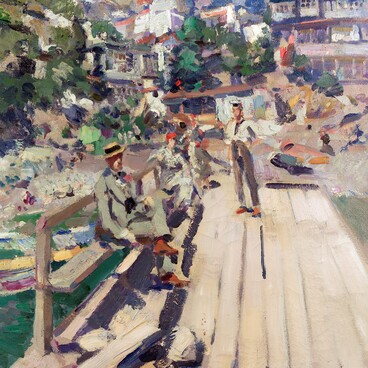A very interesting semi-parade portrait of Empress Maria Feodorovna (1759–1828) from the collection of the Vasnetsov Brothers Art Museum was painted by an unknown artist in the second half of the 18th century.
According to the study, the portrait specifies: ‘the wife of Paul I’, which probably indicates the dating of the creation between 1796 and 1801. The State Tretyakov Gallery carried out an examination and the specialists assumed that the painting was created in the last quarter of the 18th century. However, it was not possible to establish the authorship of the work.
The Empress is depicted in a slight three-quarter turn, against a dark olive background. The figure itself is made in pearl gray, milky tones, and brighter color accents are placed in the image of Maria Fedorovna’s attire. The artist gently sculpts the image of the model, as if dissolving the contours of the appearance. The woman’s face is conveyed with gentle strokes, facial features are modeled by a light play of chiaroscuro. A pearl thread and a scarf of the same shade are woven into a tall wig.
The blue sling of the Order of St. Andrew the First-Called indicates the model’s high social status. This version of wearing the ribbon was specially designed for the mantle. There was also a variation for special occasions. At the same time, the model shows a red sling with silver stitching, which was the Order of the Grand Cross, or the highest degree. Only persons of imperial blood we allowed to wear it.
The Empress, nee Sophie Dorothea Augusta Louise of Württemberg, came from what is now Poland (formerly Prussia). She received a home education. She married the Russian Emperor Paul I (1754-1801). According to researchers, she was an exemplary wife and gave birth to ten children.
Thanks to the empress, the first literary club was opened. During her marriage she was engaged in the Institute for Noble Maidens. After the death of her husband, she was closely involved in women’s education in the Russian Empire. Thanks to her initiative, women’s educational institutions were opened in several cities. Contemporaries also noted her strong creative side: Maria Fedorovna painted, created various products from ivory, amber and semiprecious stones.
According to the study, the portrait specifies: ‘the wife of Paul I’, which probably indicates the dating of the creation between 1796 and 1801. The State Tretyakov Gallery carried out an examination and the specialists assumed that the painting was created in the last quarter of the 18th century. However, it was not possible to establish the authorship of the work.
The Empress is depicted in a slight three-quarter turn, against a dark olive background. The figure itself is made in pearl gray, milky tones, and brighter color accents are placed in the image of Maria Fedorovna’s attire. The artist gently sculpts the image of the model, as if dissolving the contours of the appearance. The woman’s face is conveyed with gentle strokes, facial features are modeled by a light play of chiaroscuro. A pearl thread and a scarf of the same shade are woven into a tall wig.
The blue sling of the Order of St. Andrew the First-Called indicates the model’s high social status. This version of wearing the ribbon was specially designed for the mantle. There was also a variation for special occasions. At the same time, the model shows a red sling with silver stitching, which was the Order of the Grand Cross, or the highest degree. Only persons of imperial blood we allowed to wear it.
The Empress, nee Sophie Dorothea Augusta Louise of Württemberg, came from what is now Poland (formerly Prussia). She received a home education. She married the Russian Emperor Paul I (1754-1801). According to researchers, she was an exemplary wife and gave birth to ten children.
Thanks to the empress, the first literary club was opened. During her marriage she was engaged in the Institute for Noble Maidens. After the death of her husband, she was closely involved in women’s education in the Russian Empire. Thanks to her initiative, women’s educational institutions were opened in several cities. Contemporaries also noted her strong creative side: Maria Fedorovna painted, created various products from ivory, amber and semiprecious stones.

